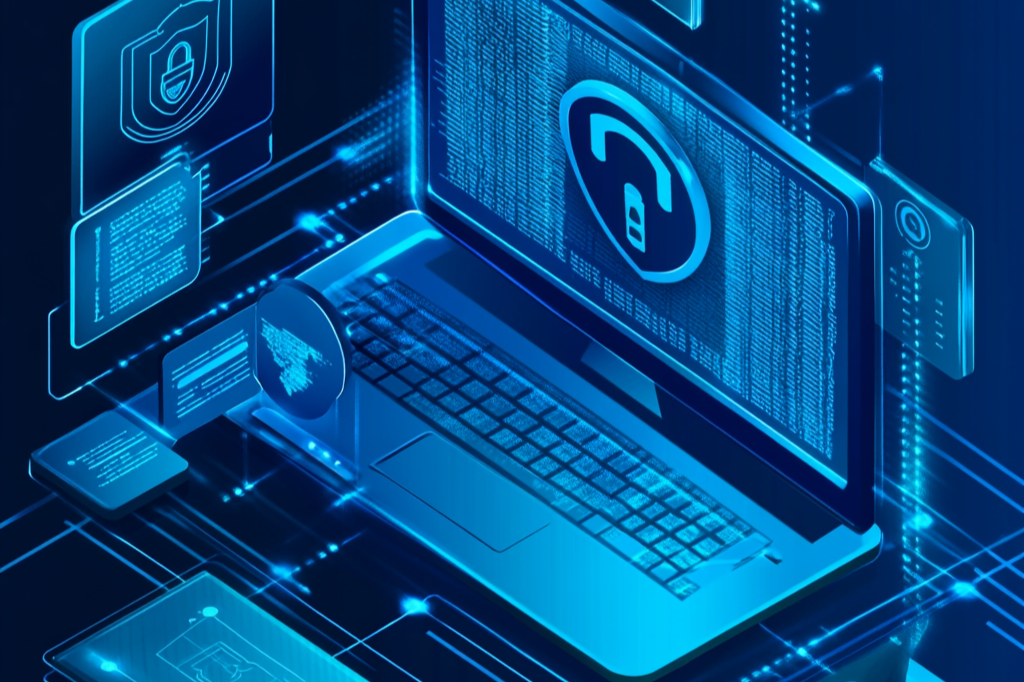In today’s digital era, cybersecurity has been a prime concern for small and medium-sized businesses (SMEs) and big companies alike. Although smaller businesses are susceptible to the same threats as big businesses, they typically lack the funds available to invest in complex security frameworks. Endpoint threat detection and response (ETDR) is one of the most effective methods of defense for an organization’s digital assets.
This article discusses ways in which SMEs can leverage endpoint threat detection and response technologies and processes to protect their networks, and why managed services like managed endpoint threat detection and response are gaining more and more popularity in small businesses.
What is Endpoint Threat Detection and Response?
Endpoint threat detection and response is a general cybersecurity solution that is designed to scan and protect devices that are connected to a network, referred to as endpoints. They can be computers, mobile phones, servers, or any other connected device. ETDR tools and best practices help to detect, analyze, and respond to security incidents on these devices in real-time, and this helps businesses close the threats early enough.
Traditional antivirus software has been the go-to option for endpoint security for decades. However, with increasingly sophisticated and evolving cyber threats such as ransomware, phishing, and zero-days, basic antivirus cannot protect anymore. It takes security a step further by using behavior analysis, machine learning, and real-time scanning to detect unusual behavior that may lead to an attack, even if the specific threat has never been seen before.
Why Endpoint Threat Detection and Response is Crucial for Small and Medium Enterprises
Small and medium enterprises (SMEs) have been the preferred target of cybercrooks due to their alleged vulnerability in security measures. Most SMEs, however, do not have the financial means to pay for full-time IT security staff or spend hundreds of thousands of dollars on high-volume-scale security hardware, so they are like easy prey to strike.
Implementing ETDR can greatly strengthen the security stance of SMEs by providing the practices and technologies necessary to neutralize increasingly advanced attacks. The following are some reasons why SMEs should consider endpoint threat detection and response as a vital component of their cybersecurity plan:
1. Increasing Threats to Small and Medium Enterprises
Cyberattacks are increasingly common, and more sophisticated techniques are being used by cybercriminals to target SMEs. Ransomware, for example, has become one of the most common attacks, and small companies are still deemed soft targets. It allows businesses to detect and capture this type of attack in the early phase, even before it has any effect.
2. Lack of Internal Security Resources
Most SMEs do not have the resources to pay for big cybersecurity teams, so even though the company is vulnerable, there are minimal internal resources to watch threats 24/7. Through managed endpoint threat detection and response, small businesses can outsource expert-level security services without having to recruit additional staff.
3. Regulatory Compliance Requirements
Many industries, including finance, healthcare, and retail, have strict data protection regulations that require companies to secure their endpoints as well as sensitive information. Having an endpoint threat detection and response solution in place guarantees compliance with such standards as GDPR, HIPAA, and PCI-DSS, which can save companies costly fines and reputational harm.
Key Features of Endpoint Threat Detection and Response for SMEs
When selecting endpoint threat detection and response tools and practices, SMEs should look for solutions that offer a range of critical features. These tools must provide comprehensive, efficient, and scalable security for endpoints, as well as align with the specific needs of smaller organizations. Below are the key features that any ETDR solution should include:
1. Real-Time Threat Monitoring
One of the most important capabilities of endpoint threat detection and response tools is real-time monitoring. These tools continuously track activity across all endpoints on the network, allowing for immediate detection of suspicious behaviors or anomalies. This enables businesses to address threats before they spread and cause significant damage.
2. Advanced Threat Detection
Advanced EDR tools use machine learning, artificial intelligence, and behavior-based analytics to detect threats that have never been seen before. Unlike traditional antivirus software that relies on signature-based detection, endpoint threat detection and response solutions focus on detecting abnormal activities that indicate malicious intent, such as unusual file access patterns, unexplained data transfers, or unauthorized login attempts.
3. Automated Response Capabilities
In addition to detecting threats, ETDR tools can automatically respond to potential threats. This might involve isolating a compromised device from the network, blocking harmful processes, or automatically rolling back malicious changes to system files. These automated responses help reduce the workload for security teams and minimize the time needed to contain an incident.
4. Incident Investigation and Forensics
When a threat is detected, it’s important to understand the full scope of the attack. Endpoint threat detection and response tools and practices often include detailed forensics capabilities, allowing security teams to analyze and investigate the attack. This includes tracking the origin of the threat, determining what systems were impacted, and gathering data for compliance or legal purposes.
5. Integration with Other Security Systems
Many SMEs already use other security systems such as firewalls, intrusion detection systems (IDS), and SIEM platforms. The best ETDR tools integrate seamlessly with these existing security solutions. This ensures that threat data is shared across the network and enables security teams to correlate information from different sources, improving their overall security posture.
Managed Endpoint Threat Detection and Response: A Solution for Small and Medium Enterprises
While ETDR is critical for SMEs, implementing and managing these tools can be complex, especially for businesses without dedicated IT security teams. This is where managed endpoint threat detection and response services can play a key role.
Managed detection and response endpoint threat services are designed for businesses that want the benefits of advanced endpoint security but lack the internal resources to manage it. Third-party vendors typically provide these services and include continuous monitoring, threat detection, and response capabilities managed by a team of experts.
Benefits of Managed Endpoint Threat Detection and Response
1. Expert-Level Security Without In-House Resources
With managed ETDR, SMEs gain access to highly skilled cybersecurity professionals who can effectively manage and respond to threats. This is particularly beneficial for smaller businesses without the budget to hire a full-time security team.
2. 24/7 Monitoring and Rapid Response
Cyber threats don’t keep office hours, which is why managed detection and response endpoint threat services provide around-the-clock monitoring. This ensures that threats are detected and dealt with as soon as they arise, minimizing the risk of prolonged exposure and damage.
3. Comprehensive Threat Detection
Managed ETDR solutions offer advanced threat detection methods that combine behavioral analytics, machine learning, and real-time monitoring to detect sophisticated attacks. This provides SMEs with enterprise-level protection, even with limited resources.
4. Cost-Effectiveness
Outsourcing endpoint threat detection and response management to a managed service provider can be more cost-effective than building an in-house team. SMEs only pay for the services they use, which can be more affordable than hiring dedicated staff to monitor and respond to threats.
How to Choose the Right Endpoint Threat Detection and Response Tool for Your Business
Choosing the right ETDR tool can be challenging, but there are several key factors to consider that will help ensure you get the best solution for your needs.
1. Assess Your Security Needs
Before selecting a tool, assess the types of threats your business is likely to face, the number of endpoints you need to protect, and your budget. Consider your business’s size and any regulatory requirements that might affect your security needs.
2. Look for Scalable Solutions
As your business grows, so will your security needs. Choose an endpoint threat detection and response tool that can scale with your organization and handle an increasing number of devices and network complexity.
3. Consider Integration Capabilities
Ensure that the EDR tool integrates with your existing security systems, such as firewalls and SIEM solutions. This integration enables a more unified approach to security, making it easier to detect and respond to threats.
4. Evaluate Pricing Models
Look at the pricing structure of different ETDR tools and practices. Some solutions are priced per endpoint, while others may offer tiered pricing based on the number of features you need. Make sure to choose a tool that offers the right balance of cost and functionality.
5. Test the Solution
Many vendors offer free trials or demos of their endpoint threat detection and response tools. Take advantage of these opportunities to test the solution’s usability and effectiveness before making a final decision.
Conclusion
For small and medium enterprises, protecting endpoints is essential in maintaining a strong security posture. Endpoint threat detection and response tools offer an effective way to detect, prevent, and respond to cyber threats in real time. With the added complexity of modern cyberattacks, implementing the best ETDR solutions will provide SMEs with the necessary tools to defend against these advanced threats.
Whether businesses choose to manage their own security or opt for managed ETDR services, understanding the benefits of these tools and practices is key to ensuring robust protection. By carefully selecting the right solution, SMEs can enhance their security, minimize risks, and focus on growing their business with confidence.


